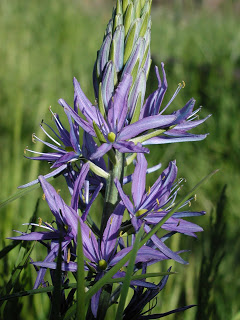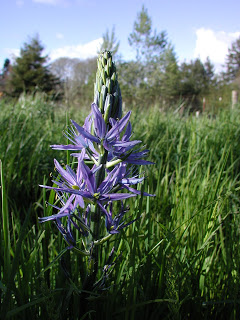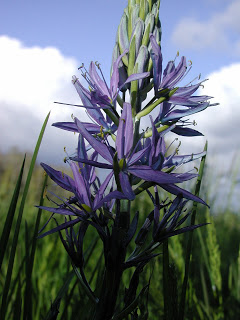One of the first things I fell in love with during my first Spring in the Willamette Valley was the camas. Lining roadsides, in patches along trails and natural areas, in many folks back yards, and in waving masses of blue out in the fields and wetlands, this plant is a beautiful sight to behold. Camas (Camassia sp.) belongs to the lily family, and posesses a rich history as one of the most important root foods (a bulb to be more exact) of indigenous peoples of western North America. Families maintained their own camas patches, year after year through the generations, using fire to manage the grasslands and increase yields, removing patches of the top sod layer either before or right after blooming, and digging the bulbs out with forked digging sticks. Then they roasted the bulbs in pits for days to break down the undigestable inulin compounds and enjoyed it as a starchy staple. Often it was dried into cakes for consumption throughout the Winter months.
Camas prefers an ephemeral habitat drying out at the end of the Spring, such as prairies, meadows, wet hillsides, stream corridors, and floodplains. Unfortunately, the type of habitats favorable to camas are also favorable for growing crops, and much of this plant’s habitat has been converted to farmland. I have heard it said that when Lewis and Clark came over a crest of mountains and beheld their first view of a vast camas prairie rippling in the breeze like waves, they mistakenly thought they had reached the ocean and recorded this in their journals. I like to imagine what that must have looked like.
Knowing it once grew all over our wet, marshy grasslands and forests in this area, I have long held a desire to re-introduce it onto our property. It grows in our neighbor’s back field, so I know we are definitely in the native habitat. I didn’t get the timing right to gather and broadcast some seeds, so this last Fall I put in a few bulbs out in our field and in the garden beds around the house. In the past week or so, I was thrilled to see camas blooming in my garden and to spot one bright blue flower stalk rising up out of the tall grass behind our house. We keep some portions of the yard both mowed and un-mowed, and I could have planned a little better with camas locations, but at least this one made it! I hope that its seeds will scatter far and wide, creating a whole patch next year.
For more information on our native camas, you can read this great USDA fact sheet at:
Be sure to educate yourself before harvesting any bulbs as to protected areas, ethical wildcrafting practices, proper preparation and the look-alike death camas. With the vast reduction in habitat, most camas harvest nowadays is done with permits in salvage operations. I still have yet to harvest any myself for all the complexitites I’ve listed above, but one day I hope to add it to my wild food experiences. For the time being, I’ll just add it to my yard!



Gonna make another trip to the roadside ditch where I collected bulbs last year. (Only one survived the winter.) I'm going to get bulbs AND seeds this time, and scatter them in the part of our field we don't mow until August. I hope to see a few blue blossoms this time next year!
Just the other day, when we were driving home from market, we were oohing and aahhing over the fields with these. How fascinated to learn more about them. I love hearing about how they were prepared to eat. And I love reading about Lewis and Clark.